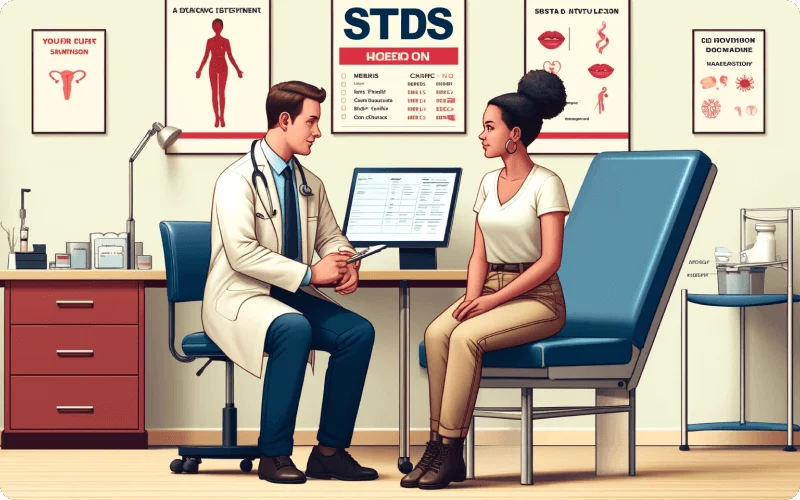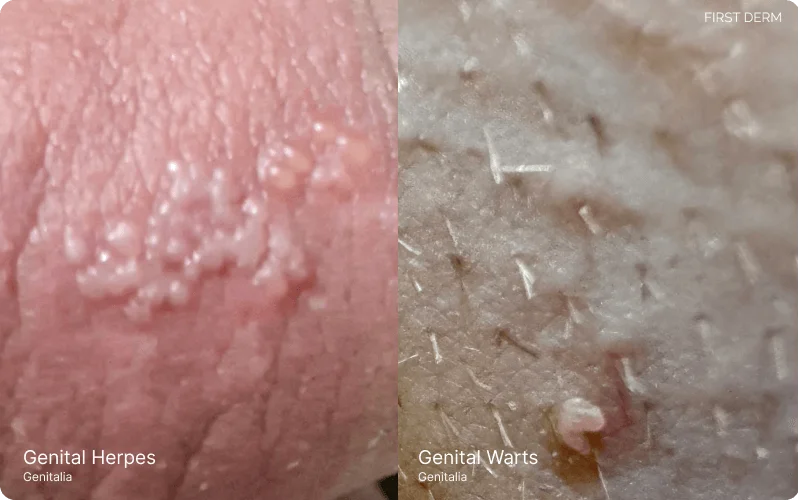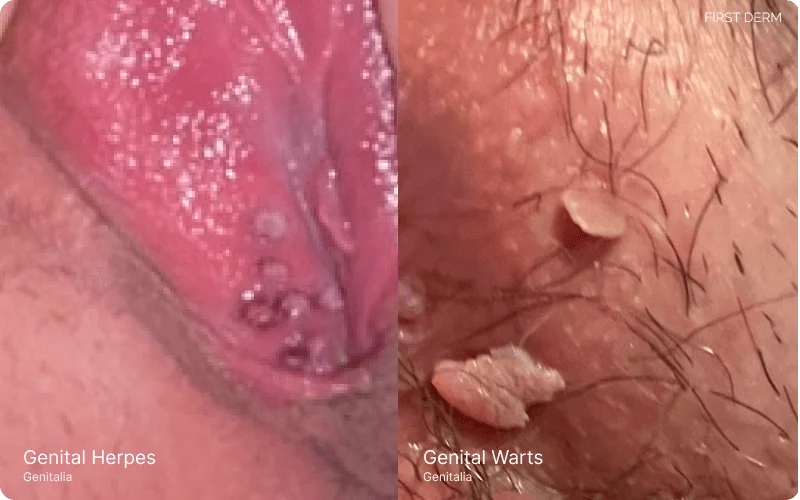Genital Warts vs Genital Herpes: Spot the Differences

Key Takeaways
-
Distinct Viruses: Genital herpes is caused by the herpes simplex virus, while genital warts are caused by certain strains of the human papillomavirus (HPV).
-
Symptom Differences: Genital herpes typically presents with painful blisters or sores, whereas genital warts appear as flesh-colored or grey swellings, often in clusters.
-
Transmission: Both conditions are primarily transmitted through skin-to-skin contact during sexual activities, and transmission can occur even when symptoms are not visible.
-
Treatment Options: There is no cure for genital herpes; treatment focuses on managing symptoms and outbreaks. Genital warts treatments aim to remove warts but do not eliminate the virus.
-
Prevention Critical: Using condoms, receiving HPV vaccinations, and disclosing STI statuses to partners are vital steps in reducing the risk of transmission and managing these conditions effectively.
Sexually transmitted infections (STIs) are a significant public health concern, affecting millions of people worldwide. Among these STIs, genital herpes and genital warts are two common conditions that can significantly impact a person’s quality of life.
Although they share some similarities, such as being primarily transmitted through sexual contact, these two conditions are caused by different viruses and have distinct signs, symptoms, and treatment options.
Overview of Genital Herpes and Genital Warts
Genital Herpes
Genital herpes is a common sexually transmitted infection caused by the herpes simplex virus (HSV-1 and HSV-2). This viral infection manifests as painful blisters or sores on the genitals, anus, or mouth. Individuals infected with genital herpes may experience flu-like symptoms, itching, or burning before the outbreak of sores.[1]
The virus can be transmitted through skin-to-skin contact, including sexual intercourse and oral sex, even when visible sores are not present. Genital herpes is a lifelong condition with recurrent outbreaks, as there is currently no cure.
Genital Warts
Genital warts are caused by certain strains of the human papillomavirus (HPV). These warts appear as small, flesh-colored or grey swellings in the genital area and may form clusters with a cauliflower-like appearance.[2] Unlike genital herpes, genital warts are usually painless.
The transmission of HPV occurs through skin-to-skin contact, especially during sexual activities, and can happen even when warts are not visible. While most cases of genital warts do not lead to serious health issues, some HPV strains can increase the risk of cervical, penile, and other types of cancer.
Visual Symptom Comparison: Genital Herpes and Genital Warts in Men and Women
Visual Symptom Comparison: Genital Herpes and Genital Warts in Men

User Two genitial conditions on the penile shaft: Genital Herpes represented by small grouped blisters on red inflamed skin, and Genital Warts depicted as keratinized hard papules.
Visual Symptom Comparison: Genital Herpes and Genital Warts in Women

Two genital conditions on the vaginal area: Genital Herpes represented by small grouped blisters on red inflamed skin, and Genital Warts depicted as keratinized hard papules
Comparative Analysis: Genital Herpes vs. Genital Warts
|
Feature
|
Genital Herpes |
Genital Warts |
|
Causing Virus
|
|
|
|
Transmission
|
|
|
|
Visual Differences |
|
|
|
Symptom Onset Times
|
|
|
|
Common Misconceptions |
|
|
|
Diagnostic Tests |
|
|
|
Process of Diagnosis |
|
|
|
Importance of Medical Consultation |
|
|
|
Treatment Methodologies |
|
|
|
Pharmaceutical Interventions |
|
|
|
Procedural Interventions |
|
|
|
Psychological Support |
|
|
|
Prevention Strategies |
|
|
|
Impact on Pregnancy |
|
|
|
Long-term Health Implications |
|
|
Living with Genital Herpes or Genital Warts
Managing Symptoms and Reducing Outbreak Frequency
Genital Herpes:
- Antiviral medications to reduce symptoms and frequency of outbreaks.[6]
- Lifestyle adjustments, such as stress management and avoiding triggers, can help reduce outbreak frequency.
- Regular medical check-ups and monitoring to track outbreaks and adjust treatment plans as necessary.
Genital Warts:
- Topical treatments, cryotherapy, and surgical removal to remove warts.[4]
- Regular medical check-ups to monitor wart recurrence and adjust treatment plans as necessary.
- Lifestyle adjustments, such as maintaining a healthy immune system, can help reduce wart recurrence.
Communication with Partners and Maintaining Healthy Relationships
- Disclose STI status to partners to enable informed decision-making.
- Practice safe sex by using condoms or dental dams to lower transmission risk.
- Communicate openly about concerns, fears, and strategies for managing the condition.
- Seek support from partners, friends, and family to maintain healthy relationships.
Living with genital herpes or genital warts requires a holistic approach that involves managing symptoms, reducing outbreak frequency, communicating openly with partners, and maintaining healthy relationships.
Preventive Measures and Managing Recurrences
- Safe Sex Practices: Practicing safe sex, including the use of condoms, can help reduce the risk of infections that may lead to Bartholin’s cysts. Maintaining good sexual hygiene is essential for overall vaginal health.[7]
- Hygiene: Maintaining proper hygiene in the genital area, including regular cleansing with mild soap and water, can help prevent infections and blockages in the Bartholin’s glands.
Recurrences and Long-Term Management
- Recurrence Expectations: Understanding that Bartholin’s cysts may recur is important. Individuals should be aware of the signs and symptoms of recurrence and seek medical advice promptly if they suspect a new cyst or abscess.
- Long-Term Management: Developing a long-term management plan with healthcare providers can help individuals navigate potential recurrences effectively. This may involve regular check-ups, monitoring symptoms, and adjusting treatment strategies as needed to prevent complications.
Frequently Asked Questions
Q: Can genital herpes or genital warts affect ability to have children?
A: Genital herpes and genital warts generally do not affect fertility, but in rare cases, complications during pregnancy may arise.
Q: Should I be concerned about genital herpes or genital warts during pregnancy?
A: Yes, genital herpes can potentially be transmitted to the baby during delivery, requiring a C-section if active lesions are present. Genital warts rarely affect pregnancy but can complicate childbirth if they are large. HPV can be transmitted to the baby but is uncommon and usually not harmful.
Q: Can HPV vaccination prevent genital warts?
A: HPV vaccination can help protect against certain strains of HPV that cause genital warts, but it does not provide complete protection against all strains.
References
- STD Facts – Genital Herpes. Published 2024. Accessed April 20, 2024. https://www.cdc.gov/std/herpes/stdfact-herpes.htm
- Batista CS, Atallah ÁN, Saconato H, Silva. 5-FU for genital warts in non-immunocompromised individuals. Cochrane library. Published online April 14, 2010. doi: https://doi.org/10.1002/14651858.cd006562.pub2
- What are the treatment options for genital herpes? Nih.gov. Published July 12, 2018. Accessed April 22, 2024. https://www.ncbi.nlm.nih.gov/books/NBK525771/
- Kore VB, Ashish Anjankar. A Comprehensive Review of Treatment Approaches for Cutaneous and Genital Warts. Curēus. Published online October 25, 2023. doi: https://doi.org/10.7759/cureus.47685
Ask a Dermatologist
Anonymous, fast and secure!

Dr. Raquel Molina Martinez is a board-certified dermatologist from Barcelona with over a decade of experience. Trained at Gothenburg’s University Hospital, she now practices at Centre Medic in Catalonia.

